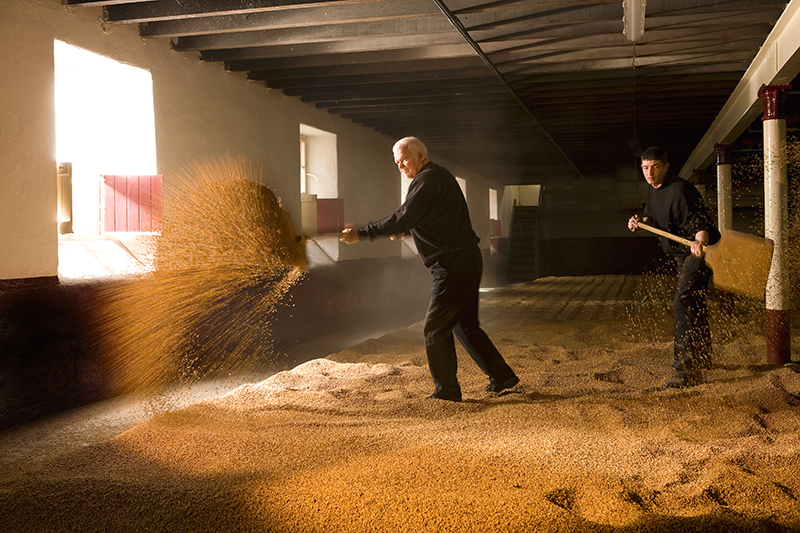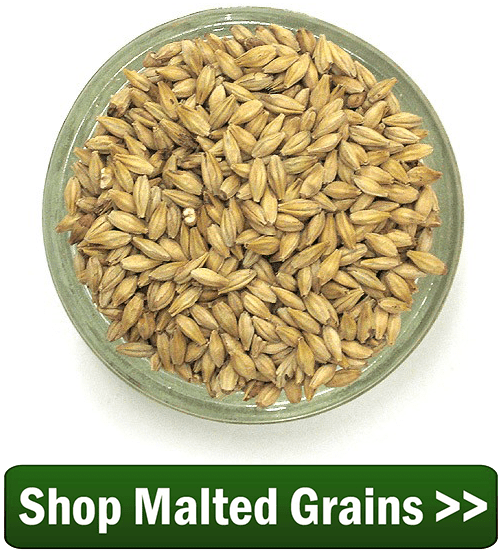 Malted barley is one of the four essential building blocks of beer. (The other three are water, hops, and yeast.) Most commercial beer is made with malted barley, though some beers are made with wheat malt, rye malt, and other cereal grains. So, what is malted barley?
Malted barley is one of the four essential building blocks of beer. (The other three are water, hops, and yeast.) Most commercial beer is made with malted barley, though some beers are made with wheat malt, rye malt, and other cereal grains. So, what is malted barley?
Barley is a grass that comes in a 2-row or 6-row variety, which corresponds to way the grains are arranged around the barley stem. Barley grains (also called corns) are the seeds of the plant that in optimal conditions will grow into a plant. The corns store energy in the form of starch, a complex sugar, so that the plant can grow.
These sugars are what brewers use to make beer. The grain provides the sugar that feeds the yeast, which in turn converts the sugar into alcohol and CO2. But before these sugars can be used, they must be made accessible through a process called malting.
The Malting Process
Malting the barley is a three-step process carried out by a professional maltster. Using a variety of barley grown specifically for making beer, the maltster creates conditions that encourage the barley corns to grow, then kilns the barley corns before they have a chance to grow into plants:
- Steeping – The maltster soaks the barley in large steeping tanks, aerating the malt and maintaining a constant, cool temperature that discourages microbial growth. The water is periodically replaced, which gives the barley a chance to breathe.
- Germination
 – The barley is then moved to the floor where it is allowed to sprout. During this phase, enzymes are activated in the barley. The enzymes begin to break down the cellular structure of the grain, which makes the starches accessible for conversion into fermentable sugars. The barley will typically be turned regularly to prevent the rootlets, or “chits,” from getting tangled. The degree to which the barley is allowed to grow is called “modification.”
– The barley is then moved to the floor where it is allowed to sprout. During this phase, enzymes are activated in the barley. The enzymes begin to break down the cellular structure of the grain, which makes the starches accessible for conversion into fermentable sugars. The barley will typically be turned regularly to prevent the rootlets, or “chits,” from getting tangled. The degree to which the barley is allowed to grow is called “modification.”
- Kilning – The final step in malting the barley is the kilning. The maltster kilns the grain to stop the growing process, which preserves the starches and the enzymes for use in brewing. Depending on the style of malt produced, grains are kilned between 175-400°F. This step introduces color and flavor to the malt as the proteins and sugars are heated in the kiln.
Common Types of Malted Barley
Malted barley is generally categorized by color and given a Lovibond number rating between 1 and 500 to rate the color (1 being pale; 500 being black). These are several of the most common malted barleys:
- Pilsen Malt – This very lightly kilned malted barley is ideal for lagers, but can also be used as base grain for ales. (1° Lovibond)
- 2-Row Malt – A very common base malt for ales and lagers. 2-Row malt typically contains more fermentable sugar and less protein than 6-Row malt. (1.8° Lovibond)
- 6-Row Malt – 6-Row is often used for lagers for its grainy flavor. 6-Row barley is primarily grown in the US. (1.8° Lovibond)
- Vienna Malt
 – Vienna malt is kilned slightly more than Pilsen and 2-Row malts, but it still works well as a base malt. It is recommended for use in Pilsners and Vienna-style lagers. (3.5° Lovibond)
– Vienna malt is kilned slightly more than Pilsen and 2-Row malts, but it still works well as a base malt. It is recommended for use in Pilsners and Vienna-style lagers. (3.5° Lovibond)
- Munich Malt – Munich malt is a well-modified malt that lends a sweeter, maltier flavor than the lighter malts. It is ideal for amber ales, Märzen lagers, and dark lagers. (10° Lovibond)
- Crystal Malt – A wide range of malted barleys are kilned at higher temperatures and called crystal, or caramel malts. They range from 10 to 120 degrees Lovibond, contributing significant color and sweet caramel flavor. (10-120° Lovibond)
- Chocolate Malt – Chocolate malt is often used (in moderation) for brown ales, porters, and stouts. It contributes a chocolate-like flavor and aroma to beer; it is not actually made with chocolate. (350° Lovibond)
- Black Malt – Black malt has been kilned nearly to the point of burning. It provides roasty, astringent bitterness and very dark color to stouts and other dark beers. Very little needs to be used to get the desired effect. (500° Lovibond)
Want to learn more about malted barleys? This book is a great resource if you want to learn more about malts or homebrewing in general: Homebrewing for Dummies
Now that you know the answer to the question: “what is malted barley?”, what are some of your favorite malts for brewing beer at home? And, what brews do you use them in?
—–
Ed Kraus is a 3rd generation home brewer/winemaker and has been an owner of E. C. Kraus since 1999. He has been helping individuals make better wine and beer for over 25 years.
